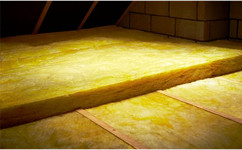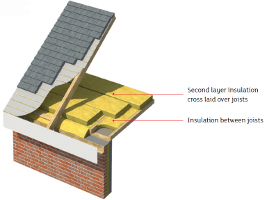Loft Insulation Shopping Guide

It is Time to Prepare for the Summer with Loft Insulation
With hot summer months approaching, we are all trying to find some efficient ways of cooling down our home. Although some simple tricks like proper window blinds, a few fans and a shaded porch may offer some assistance, these are usually not permanent solutions and can only partially solve the problem. if you are looking for a more permanent solution that can help you provide a moderate temperature heaven that will be pleasing both during the summer and winter, offering a shade or a warm, cozy area within your home you can use for yourself or your guests. If your home has an old, unused loft space that is only draining the heat during the winter or letting it in during the summer, now would be the perfect time to consult our loft insulation shopping guide.
Apart from all the benefits that fitting loft insulation has for your comfort, it is also very cost-efficient since it will allow you to save considerable amount of money on electricity bills, not to mention the CO2 savings. The cost efficiency is determined by comparing the purchase and installation costs on one hand and the savings and time required to get back the money invested, on the other. This will depend on whether you are only upgrading the existing insulation (please bear in mind that the recommended thickness of insulation in this case is 270mm) or you are starting from the scratch. Another important factor is the type of home you are insulating that is whether you are dealing with detached, semi-detached or a mid-terrace house, for instance. Also, it is clear that you will save some money if you decide to install the insulation yourself, than if you decide to hire a professional contractor. The studies in the UK have shown that, if you are adding a layer of insulation of 270mm (installing new instead of upgrading the existing insulation) the insulation costs vary from £280 (for a mid-terrace house) to £400 (for a detached house). On the other hand, yearly savings are around £140 for a mid-terrace house and around £250 for a detached, four bedrooms house. Finally, this means that the payback times are 1-2 years. Added insulation can also improve your home’s energy rating, expressed through the energy performance certificate, which is a must in case you have decided to sell your property. It can be rated as A as the best energy performance grade, or as G, as the worst.


If you are wondering whether to insulate your loft or opt for some roof insulation, please note that if you are planning on using your loft space for more than just storage, then it would be wiser to insulate your roof. If this is not the case, then it we advise you choose the loft, sine the installation is much easier and cheaper. Also, if you are planning to use the loft for storage and are concerned that adding insulation will take much of the space, the problem can be solved by for example, installing some rock wool between the joists and covering it with some rigid insulation board and wood boarding. Another option is to raise the floor level and add some insulation beneath.
Which Loft Insulation Type to Go for?
If you are determined to add some insulation to your loft, then the only thing left is to choose the best insulation material. There are many types and products available on the market, why it is not always easy to make the final decision. We advise you first set the criteria that are important for yourself (such as the price, since some materials are much more expensive than others) or that are dictated by the characteristics of your property (such as the accessibility of the loft space). The available types of loft insulation include:
- the most popular blanket or roll insulation, which includes some rock wool, glass or sheep wool insulation packed in slabs or rolls, which is very easy to install, can be a more eco-friendly option (sheep wool in particular) but can be however hard to install properly around obstacles which are common in loft spaces;
- another popular, but usually more expensive loft insulation option are rigid insulation boards, which are among the most efficient insulation materials available and can be successfully combined with some plasterboards if you are looking for a more effective finish;
- if you are dealing with a hardly accessible loft space, then you will need some more flexible insulation materials, such as blown-in or loose-fill insulation. Both types are inserted into the loft space by using special equipment (why they must be installed by a professional) and are ideal to install around obstructions or as an upgrading loft insulation option. However, we advise you avoid installing in draughty lofts, since it is not as stable as other insulation materials.
Once you have chosen the insulation material, you will have to decide whether you are going to install it yourself or hire a professional. Please note that although turning loft insulation into a DIY project can cut down your expenses, some materials are better installed by a professional, since installation may include some preparatory work such as clearing the loft or taking care of wiring, pipes and tanks.
For more info about loft insulation products contact Insulation Shop via email at info@insulationshop.co.











































































































